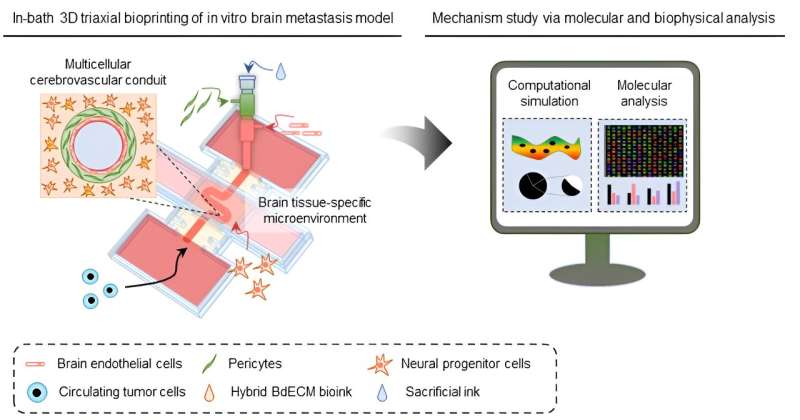This article has been reviewed according to Science X's editorial process and policies. Editors have highlighted the following attributes while ensuring the content's credibility:
fact-checked
peer-reviewed publication
trusted source
proofread
3D bioprinting sheds light on why blood vessel curvature may foster brain cancer metastasis

Recent research suggests that the winding paths of blood vessels might trigger the development of metastatic cancers, a topic gaining considerable attention in academia. A collaborative team utilized 3D bioprinting technology to reproduce intricate brain blood vessel structures in the laboratory.
Their primary focus was on uncovering the impact of blood vessel curvature on the movement of tumor cells circulating within the brain. The research findings are published in Nature Communications.
Brain metastasis, often categorized as terminal due to its grim prognosis and the challenges in treatment, occurs when cancer cells, having detached from other tissues, navigate the intricate maze of blood vessels deep within the brain to initiate the disease.
While several in vitro models have been developed to study its onset mechanisms, understanding the impact of physiological factors within brain blood vessels and their anatomical structures on metastatic cancer development has been a significant hurdle.
The team developed a specialized bioink tailored explicitly for creating brain blood vessels. The models 3D-printed using conventional ink faced challenges in accurately replicating intricate cerebral vasculature, as they encountered difficulty in preserving the structure until complete solidification.
To tackle this issue, the team created a hybrid brain-derived decellularized extracellular matrix (BdECM) by blending decellularized extracellular matrix sourced from the brain with alginate extracted from seaweed. This innovative hybrid BdECM, comprising collagen and some 2,000 other protein types, rapidly stabilizes after printing, enabling the precise replication of more intricate brain blood vessel structures than previously achievable.
The team utilized this advanced technology to engineer functional brain blood vessels comprising multiple cellular layers—endothelial, surrounding, and astrocyte/neuron layers—with varying curvatures. Their analysis of how circulating tumor cells responded to the cerebral vascular structure revealed a crucial finding: an increase in blood vessel curvature can correlate with a heightened adherence of cancer cells to the vessel walls.
Furthermore, the team investigated the molecular-level mechanisms underlying metastatic cancer development through the interactions between cancer cells and brain vascular tissues.
Subsequently, the researchers employed computer simulations with the brain blood vessel model to examine factors like blood flow velocity and wall shear stress and biophysically explored the correlation between cerebral vascular curvature and cancer cell extravasation.
The research team was led by Professor Dong-Woo Cho and Ph.D. candidate Wonbin Park from the Department of Mechanical Engineering at Pohang University of Science and Technology (POSTECH), along with Professor Byoung Soo Kim and Ph.D. candidate Jae-Seong Lee from the School of Biomedical Convergence Engineering at Pusan National University, and Professor Ge Gao from the School of Medical Technology at Beijing Institute of Technology.
Professor Dong-Woo Cho explained, "By examining the molecular and dynamic elements of cancer extravasation through bioprinted cerebrovascular models, we've delved into the disease's onset mechanisms. We envision leveraging this technology for drug development aimed at treating brain metastasis."
More information: Wonbin Park et al, 3D bioprinted multilayered cerebrovascular conduits to study cancer extravasation mechanism related with vascular geometry, Nature Communications (2023). DOI: 10.1038/s41467-023-43586-4



















